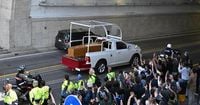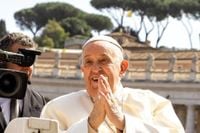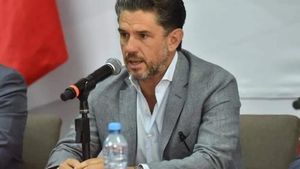On April 26, 2025, the world witnessed a historic event as the funeral of Pope Francis took place in Vatican City, drawing an estimated 250,000 mourners from around the globe. The papal funeral, held in St. Peter's Square, was marked by solemnity, reverence, and a poignant farewell to a leader known for his compassion and calls for peace.
The ceremony began with the arrival of the Pope's casket, which was carried on a modified papamobile, allowing the faithful to see the Pope one last time as it made its way through the streets of Rome. The procession covered approximately six kilometers, starting from St. Peter's Basilica and concluding at Santa Maria Maggiore, where the Pope would be laid to rest. As the papal vehicle passed, crowds erupted in applause, chanting “Viva Francesco!” in tribute to the beloved pontiff.
During the funeral service, Cardinal Giovanni Battista Re, the Dean of the College of Cardinals, delivered a moving eulogy. He emphasized Pope Francis's dedication to the marginalized and his relentless advocacy for peace amidst global turmoil. “Despite the many wars of these years, with inhumane horrors and countless deaths, Pope Francis continually raised his voice imploring peace,” Cardinal Re stated, drawing applause from the assembly.
In attendance were numerous world leaders, including U.S. President Donald Trump, French President Emmanuel Macron, and Ukrainian President Volodymyr Zelensky. The meeting between Trump and Zelensky, which took place shortly before the funeral, was described by Zelensky as “symbolic” and potentially historic, as they discussed efforts for a complete and unconditional ceasefire in Ukraine.
As the funeral unfolded, the atmosphere was charged with emotion. Mourners gathered in St. Peter's Square, many having waited for hours or even overnight to pay their respects. The event was marked by a sense of unity among diverse groups, with prayers being recited in multiple languages, reflecting the global nature of the Catholic Church.
In addition to the official dignitaries, ordinary citizens also came out in droves to honor the Pope. Many brought flowers and banners, some even camping out overnight to secure a spot in the square. The Vatican had set up large screens to broadcast the service to those unable to fit into the square, ensuring that as many people as possible could participate in the farewell.
The funeral service included traditional Catholic rites, with the first reading in English, the responsorial psalm in Latin, and the second reading in Spanish. Following the homily, the ceremony included the “Ultima Commendatio” (Final Commendation) and the “Valedictio” (Farewell), where prayers were offered for the Pope's eternal rest.
As the service concluded, the casket was transported back to Santa Maria Maggiore for burial, with the procession accompanied by the ringing of church bells and the chanting of hymns. The Pope's burial site was chosen personally by him, reflecting his deep connection to the basilica.
The day of mourning was not only a farewell but also a reminder of the Pope's legacy. His calls for compassion and justice resonated throughout the service, with leaders and mourners alike reflecting on his impact on both the Church and the world. Ursula von der Leyen, President of the European Commission, remarked, “Pope Francis built bridges; let us walk them,” highlighting the Pope's efforts to promote dialogue and understanding among different faiths.
In the days leading up to the funeral, preparations were in full swing. The Vatican had implemented extensive security measures to manage the large crowds expected for the event. The police estimated that over 200,000 people would attend, prompting a significant law enforcement presence to ensure safety and order during the proceedings.
As the funeral drew to a close, the smoke signals—historically used to announce the election of a new Pope—served as a reminder of the transitional phase the Church is entering. The Conclave, which will elect the next Pope, is expected to begin between May 5 and May 10, 2025, following the nine-day period of mourning known as the novendiali.
During this time, cardinals will gather to discuss and pray for guidance in selecting the new leader of the Catholic Church. The Conclave will be held in the Sistine Chapel, where the cardinal electors will cast their votes in a process steeped in tradition and secrecy.
As the world reflects on the life and legacy of Pope Francis, many are left pondering the future of the Church and the direction it will take under new leadership. The memory of his compassionate leadership and calls for peace will undoubtedly continue to inspire countless individuals around the globe.
In the wake of his passing, the call for unity and understanding remains ever more pressing, as leaders and citizens alike strive to honor the values that Pope Francis championed throughout his papacy. His legacy as a voice for the voiceless and a champion for peace will resonate for generations to come.






